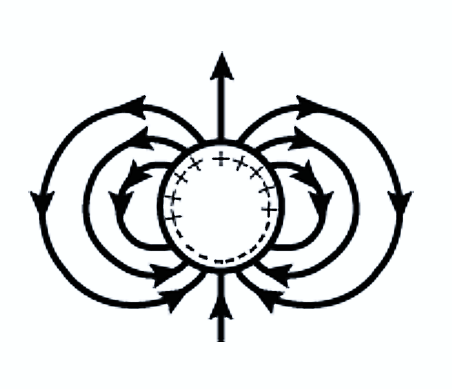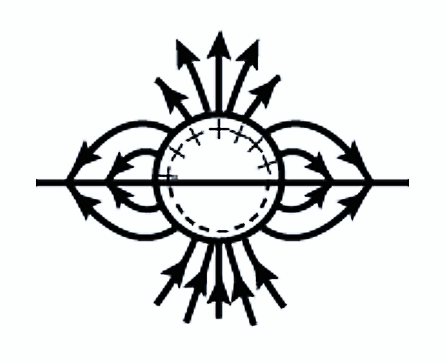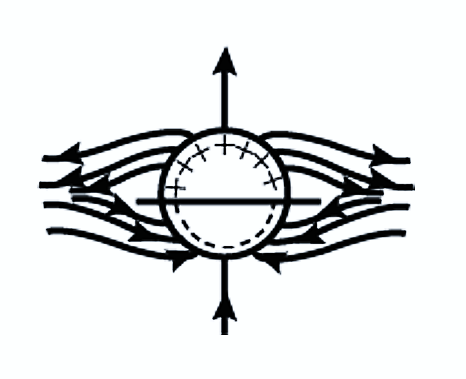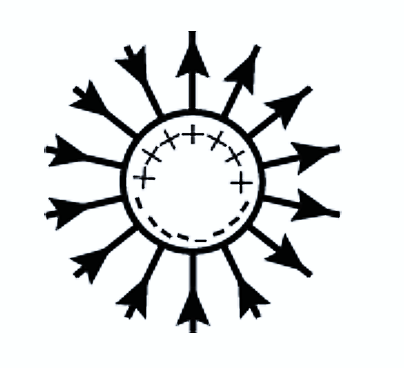
A long cylindrical shell carries positive surface charge $'\sigma'$ in the upper half and negative surface charge $'−\sigma'$ in the lower half. The electric field lines around the cylinder will look like figure given in:
(figures are schematic and not drawn to scale)
A.

B.

C.

D.





Answer
557.1k+ views
Hint: Electric field lines can be defined as the imaginary lines propagating through space. No charge is enclosed in a long cylindrical shell. We know, if there are no charges enclosed then no electric field lines will be generated. Also, the electric field lines always start at a positive charge and end at a negative charge. This basic information can be used to answer the given question.
Complete answer:
There is no charge enclosed inside a cylindrical shell. Hence, the electric field inside a shell will be zero. Thus, there will be no electric field lines inside. It is given that the shell carries positive surface charge $'\sigma'$ in the upper half and negative surface charge $'−\sigma'$ in the lower half. We know the direction of the electric field is always directed away from the positive charge and towards the negative charge. So, the electric field lines will originate from positive charges radially to the surface and terminate at the negative charges radially inwards to the surface.
Thus, the correct answer is option A.
Note:
To solve these types of questions, students must have clear knowledge about electrostatics. Students should know about the properties of electric field lines. The electric field lines are always perpendicular to the surface charge. The number of field lines is directly proportional to the magnitude of charge. If there is a single positive charge then the electric field lines end at infinity and if there is a single negative charge then the electric field lines start at infinity.
Complete answer:
There is no charge enclosed inside a cylindrical shell. Hence, the electric field inside a shell will be zero. Thus, there will be no electric field lines inside. It is given that the shell carries positive surface charge $'\sigma'$ in the upper half and negative surface charge $'−\sigma'$ in the lower half. We know the direction of the electric field is always directed away from the positive charge and towards the negative charge. So, the electric field lines will originate from positive charges radially to the surface and terminate at the negative charges radially inwards to the surface.
Thus, the correct answer is option A.
Note:
To solve these types of questions, students must have clear knowledge about electrostatics. Students should know about the properties of electric field lines. The electric field lines are always perpendicular to the surface charge. The number of field lines is directly proportional to the magnitude of charge. If there is a single positive charge then the electric field lines end at infinity and if there is a single negative charge then the electric field lines start at infinity.
Recently Updated Pages
Master Class 12 English: Engaging Questions & Answers for Success

Master Class 12 Economics: Engaging Questions & Answers for Success

Master Class 12 Social Science: Engaging Questions & Answers for Success

Master Class 12 Maths: Engaging Questions & Answers for Success

Master Class 12 Chemistry: Engaging Questions & Answers for Success

Master Class 12 Business Studies: Engaging Questions & Answers for Success

Trending doubts
What are the major means of transport Explain each class 12 social science CBSE

Which are the Top 10 Largest Countries of the World?

Draw a labelled sketch of the human eye class 12 physics CBSE

Explain sex determination in humans with line diag class 12 biology CBSE

The pH of the pancreatic juice is A 64 B 86 C 120 D class 12 biology CBSE

Explain sex determination in humans with the help of class 12 biology CBSE




